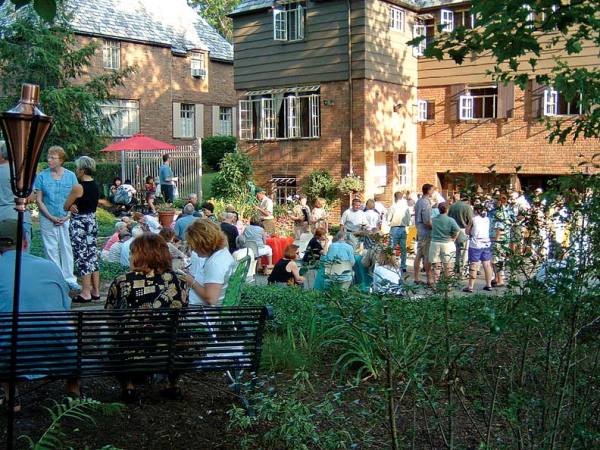
Crowds flood Cleveland’s Forest Hill for the opportunity to glimpse inside the French-Norman homes that were built on the John D. Rockefeller estate in the 1920s. (Photo: Forest Hill Preservation Society)
Every summer, I join my mother and my friend Anne Lynch on the annual Victorian house tour in Honesdale, Pennsylvania. At first, I just wanted to satisfy my curiosity about how the other half lived—you know, the half with money, great taste, and the energy to clean their houses so they could invite other people in.
But over the years, I began to realize that I was getting much more out of the house tour than sated curiosity. It had become the best resource in my quest to return my own 1820s Greek Revival to its 19th-century splendor without sacrificing modern conveniences. Over the past three years on the house-tour circuit in Honesdale, I’ve learned plenty of lessons. Here are the top 10 reasons why I never miss a chance to go on a house tour.
Browse our upcoming events to find a house tour near you.
#1: You’ll find out as much about your own taste as you will about your neighbors’.
If you’re like me, when you first start to work on your own house, you pick up a lot of books and magazines and feel flush with inspiration. This overwhelming enthusiasm—swooning over window treatments, picturing a kaleidoscope of paint colors on the walls—is inevitable. But just as inevitably, the initial rush will fade, and reality will set in. Eventually, everyone has to make their old house their old home, one you can actually live in. Seeing how other people blended their own taste with period authenticity (and, more important, my reaction to these meldings) was a lesson in how picture-perfect ideas can be adapted to the real world.
#2: You’ll discover great ideas you never considered.
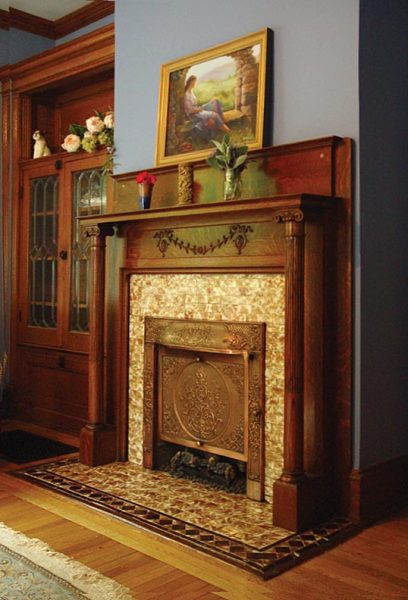
In talking with the owner of this grand 1898 Queen Anne, the author found a solution to her insulation problems. (Photo: Terry E. Smith)
If you had told me that floor-to-ceiling wallpaper with a small print of an Indian maharajah hunting deer would work brilliantly in a Victorian kitchen, I would have thought you were crazy. But it did! So, too, did the sun-starved kitchen with traditional black and white tiles, white wainscoting, and black wallpaper dotted with images of fruit. Until then, I had always been afraid of dark wallpaper, but after viewing the latter house, I learned that it all depends on how you balance it with other colors. I now plan to cover two of my bedrooms with darker wallpaper.
#3: You’ll be saved from misguided ideas.
Sometimes, it’s not a question of individual style. Sometimes the owner just gets it wrong. Incongruous modern touches like industrial ceiling tiles or recessed lighting. A Victorian living room covered in a kitsch-heavy blend of kittens, lace, and baby dolls. Awful paint over original details. As Anne told me, “The worst thing is to see a great house redone badly.” For me, it was a beautiful Victorian drawing room painted baby-poo brown—a similar color to the one I had been considering for my living room. Seeing it in real life made me realize that no matter how many paint chips you tape to the wall, you can still end up making the wrong choice.
#4: You’ll unearth unexpected decorative resources.
Complimenting the home-owners on their lovely hearth rug can lead you to a new source for reasonably priced antiques. The owner of one exquisite home I toured gave me the name of a local wallpaper outlet I had never heard of; another gave me the scoop on where she found authentic-looking but affordable kitchen curtains.
#5: You gain insight into the mechanics of older structures.
One of my greatest challenges has been figuring out how to insulate my old house. When my house was built, materials like sawdust or newspapers—or worse, nothing at all—were the norm for insulation. More recent innovations like blown-in insulation meant drilling holes and defacing the exterior of the house, and so were often avoided by old-house owners. But when I found myself in a discussion about my heating problems with the owner of a particularly large house, she clued me to another option. She’d found a specialist who had insulated her walls with blown-in cellulose, but had removed pieces of siding before drilling, and then replaced them to cover patched holes. The work had cut her heating bills by a third, she said—and she was all too happy to pass along the specialist’s name to me.
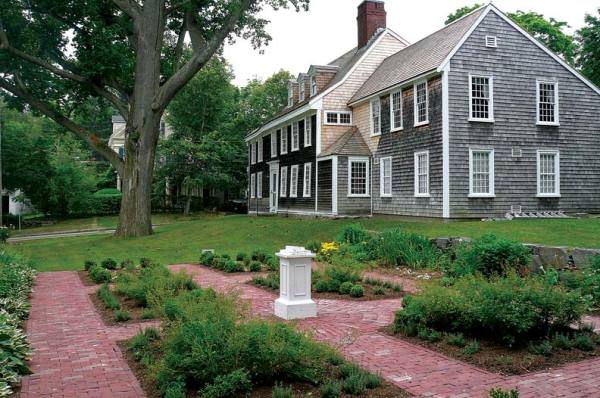
The Tour of Historic Hingham Homes in Hingham, Massachusetts, which started in 1924, is thought to be the longest-running house tour in the U.S., and highlights 17th-century buildings such as the circa-1680 Old Ordinary Tavern. (Photo: Hingham Historical Society)
#6: You learn how to strike the right balance between historical versus contemporary.
This has been another major challenge for me. Every old house is a balance of the old and the new—none of us is so committed to historical accuracy that we would forego bathrooms, electric lighting, refrigeration, or central heating. The question is how to fit them in. One of the most creative approaches I saw was the home with what looked like an original 1930s kitchen. It had delightful period moldings, vintage appliances, and cabinets painted in deep cream and forest green. “Charming!” I told the owners. “I love the way you preserved this!” “Oh, no,” they replied with a smile. “It’s new.” It turned out that the home’s original kitchen had been destroyed years before when the building was split into two apartments. Unable to re-create a kitchen on the original footprint, the homeowners converted the back porch into a kitchen and outfitted it with early 20th-century touches. Thanks to their attention to detail, it blended seamlessly with the rest of the house.
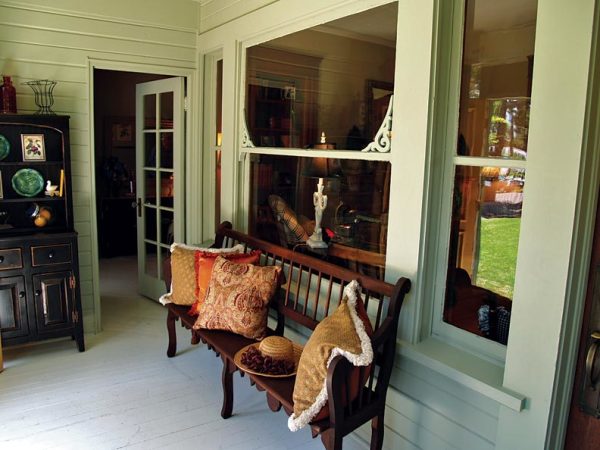
This Victorian-era sleeping porch was a highlight of the Vintage Home Tour in Corona, California. (Photo: Corona Historic Preservation Society)
#7: You’ll uncover local history.
In Honesdale, docents at each house recount gossip and history—everything from happy, unhappy, and surprising marriages to business empires (several of the original homeowners were in the shoe business) to the great floods of the Lackawaxen River, the water levels of which are still pencil-marked on the walls of many homes on Main Street. I learned of residents who achieved local renown, such as Aramis Van Deusen, Honesdale’s celebrated candy-maker, and General Lyman Lemnitzer, who served as commander of United Nations forces in Korea and Chairman of the Joint Chiefs of Staff. Uncovering the lives of those who occupied the old houses before us makes the buildings live and gives them context and meaning.
#8: You’ll start your own resource network.
No matter how much restoration work you plan to do yourself, chances are you’ll eventually need the names of good contractors and specialists. When you see something done really well, ask about it. Your fellow homeowners will gladly share war stories, and you’ll uncover fantastic tidbits about, say, where to get help scraping off peeling paint. Over the years, I’ve collected the names of the best painters, contractors, insulators, and decorators in my town. You also can find out what to keep an eye out for. Hearing how long a project took or even how much it cost can be incredibly reassuring. Some homeowners will offer up how-to information that could save you thousands of dollars. And who knows? You might even make a new friend or two.
#9: You’ll get landscaping ideas.
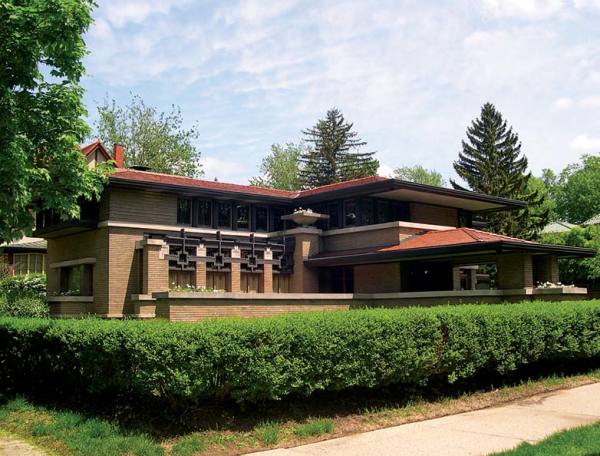
Some neighborhood tours highlight famous gems—the fall tour of Heritage Hill in Grand Rapids, Michigan, includes a stop at Frank Lloyd Wright’s 1908 Meyer May House. (Photo: Grand Rapids Heritage Hill Association)
It’s not just about the home’s interior—house tours can allow you to peek into private gardens as well, gathering tips and ideas on how to perfectly frame a historic house with plants, trees, and outbuildings. Sometimes even if you’re not wild about the house, the garden will inspire. You also can witness firsthand how good landscaping can help shape an otherwise bland setting, like the home I saw with only a tiny strip of grass for a front yard, on which the owner had planted a row of pink hibiscus topiaries bordered by a row of miniature boxwood. The flowers seemed to float like butterflies in mid-air between the tiny hedge and the porch. Other owners with more land have put in gardens in the drifting English-border style, filled with lovely period flowers. (Gardens have become such a popular feature on Honesdale’s home tour that a bonus one-day garden tour was added to the event last year.)
#10: You’ll renew your love of old homes.
More than anything else, going on a house tour will reaffirm your love for old houses. It will inspire you afresh, just as those books and magazines once did—only now you’ll be armed with realistic possibilities, thrilling ideas, a list of reliable service providers, and new friends who are on your side.
Jodi Lisswrites about rural Pennsylvania life from her 1820s Greek Revival house in Wayne County.







